Jes Frellsen
Zero-shot protein stability prediction by inverse folding models: a free energy interpretation
Jun 05, 2025Abstract:Inverse folding models have proven to be highly effective zero-shot predictors of protein stability. Despite this success, the link between the amino acid preferences of an inverse folding model and the free-energy considerations underlying thermodynamic stability remains incompletely understood. A better understanding would be of interest not only from a theoretical perspective, but also potentially provide the basis for stronger zero-shot stability prediction. In this paper, we take steps to clarify the free-energy foundations of inverse folding models. Our derivation reveals the standard practice of likelihood ratios as a simplistic approximation and suggests several paths towards better estimates of the relative stability. We empirically assess these approaches and demonstrate that considerable gains in zero-shot performance can be achieved with fairly simple means.
Exploring bidirectional bounds for minimax-training of Energy-based models
Jun 05, 2025Abstract:Energy-based models (EBMs) estimate unnormalized densities in an elegant framework, but they are generally difficult to train. Recent work has linked EBMs to generative adversarial networks, by noting that they can be trained through a minimax game using a variational lower bound. To avoid the instabilities caused by minimizing a lower bound, we propose to instead work with bidirectional bounds, meaning that we maximize a lower bound and minimize an upper bound when training the EBM. We investigate four different bounds on the log-likelihood derived from different perspectives. We derive lower bounds based on the singular values of the generator Jacobian and on mutual information. To upper bound the negative log-likelihood, we consider a gradient penalty-like bound, as well as one based on diffusion processes. In all cases, we provide algorithms for evaluating the bounds. We compare the different bounds to investigate, the pros and cons of the different approaches. Finally, we demonstrate that the use of bidirectional bounds stabilizes EBM training and yields high-quality density estimation and sample generation.
* accepted to IJCV
Hyper-Transforming Latent Diffusion Models
Apr 24, 2025Abstract:We introduce a novel generative framework for functions by integrating Implicit Neural Representations (INRs) and Transformer-based hypernetworks into latent variable models. Unlike prior approaches that rely on MLP-based hypernetworks with scalability limitations, our method employs a Transformer-based decoder to generate INR parameters from latent variables, addressing both representation capacity and computational efficiency. Our framework extends latent diffusion models (LDMs) to INR generation by replacing standard decoders with a Transformer-based hypernetwork, which can be trained either from scratch or via hyper-transforming-a strategy that fine-tunes only the decoder while freezing the pre-trained latent space. This enables efficient adaptation of existing generative models to INR-based representations without requiring full retraining.
Learning Energy-Based Models by Self-normalising the Likelihood
Mar 10, 2025Abstract:Training an energy-based model (EBM) with maximum likelihood is challenging due to the intractable normalisation constant. Traditional methods rely on expensive Markov chain Monte Carlo (MCMC) sampling to estimate the gradient of logartihm of the normalisation constant. We propose a novel objective called self-normalised log-likelihood (SNL) that introduces a single additional learnable parameter representing the normalisation constant compared to the regular log-likelihood. SNL is a lower bound of the log-likelihood, and its optimum corresponds to both the maximum likelihood estimate of the model parameters and the normalisation constant. We show that the SNL objective is concave in the model parameters for exponential family distributions. Unlike the regular log-likelihood, the SNL can be directly optimised using stochastic gradient techniques by sampling from a crude proposal distribution. We validate the effectiveness of our proposed method on various density estimation tasks as well as EBMs for regression. Our results show that the proposed method, while simpler to implement and tune, outperforms existing techniques.
Debiasing Guidance for Discrete Diffusion with Sequential Monte Carlo
Feb 10, 2025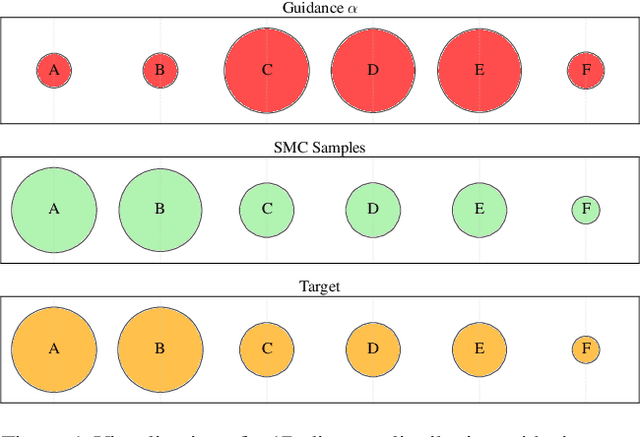
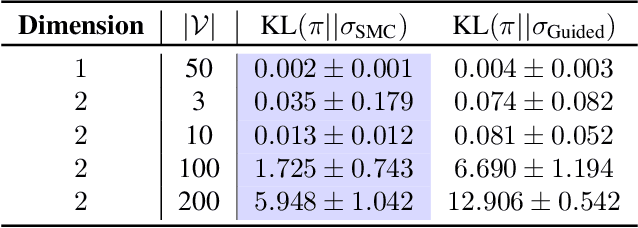
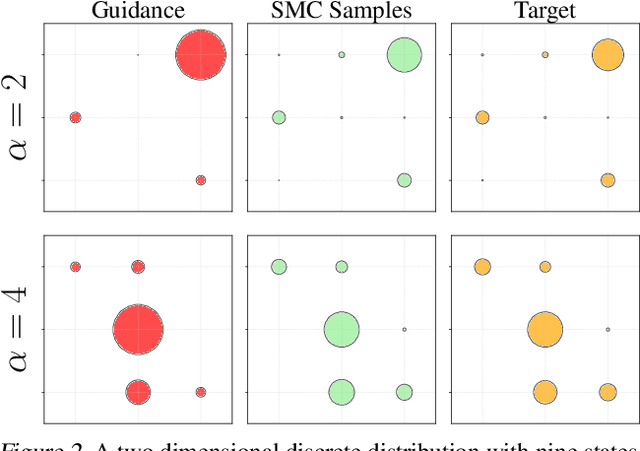

Abstract:Discrete diffusion models are a class of generative models that produce samples from an approximated data distribution within a discrete state space. Often, there is a need to target specific regions of the data distribution. Current guidance methods aim to sample from a distribution with mass proportional to $p_0(x_0) p(\zeta|x_0)^\alpha$ but fail to achieve this in practice. We introduce a Sequential Monte Carlo algorithm that generates unbiasedly from this target distribution, utilising the learnt unconditional and guided process. We validate our approach on low-dimensional distributions, controlled images and text generations. For text generation, our method provides strong control while maintaining low perplexity compared to guidance-based approaches.
GeoFormer: A Multi-Polygon Segmentation Transformer
Nov 25, 2024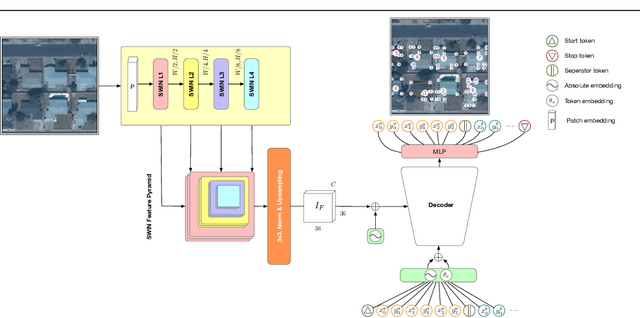



Abstract:In remote sensing there exists a common need for learning scale invariant shapes of objects like buildings. Prior works relies on tweaking multiple loss functions to convert segmentation maps into the final scale invariant representation, necessitating arduous design and optimization. For this purpose we introduce the GeoFormer, a novel architecture which presents a remedy to the said challenges, learning to generate multipolygons end-to-end. By modeling keypoints as spatially dependent tokens in an auto-regressive manner, the GeoFormer outperforms existing works in delineating building objects from satellite imagery. We evaluate the robustness of the GeoFormer against former methods through a variety of parameter ablations and highlight the advantages of optimizing a single likelihood function. Our study presents the first successful application of auto-regressive transformer models for multi-polygon predictions in remote sensing, suggesting a promising methodological alternative for building vectorization.
MolMiner: Transformer architecture for fragment-based autoregressive generation of molecular stories
Nov 10, 2024



Abstract:Deep generative models for molecular discovery have become a very popular choice in new high-throughput screening paradigms. These models have been developed inheriting from the advances in natural language processing and computer vision, achieving ever greater results. However, generative molecular modelling has unique challenges that are often overlooked. Chemical validity, interpretability of the generation process and flexibility to variable molecular sizes are among some of the remaining challenges for generative models in computational materials design. In this work, we propose an autoregressive approach that decomposes molecular generation into a sequence of discrete and interpretable steps using molecular fragments as units, a 'molecular story'. Enforcing chemical rules in the stories guarantees the chemical validity of the generated molecules, the discrete sequential steps of a molecular story makes the process transparent improving interpretability, and the autoregressive nature of the approach allows the size of the molecule to be a decision of the model. We demonstrate the validity of the approach in a multi-target inverse design of electroactive organic compounds, focusing on the target properties of solubility, redox potential, and synthetic accessibility. Our results show that the model can effectively bias the generation distribution according to the prompted multi-target objective.
EB-NeRD: A Large-Scale Dataset for News Recommendation
Oct 04, 2024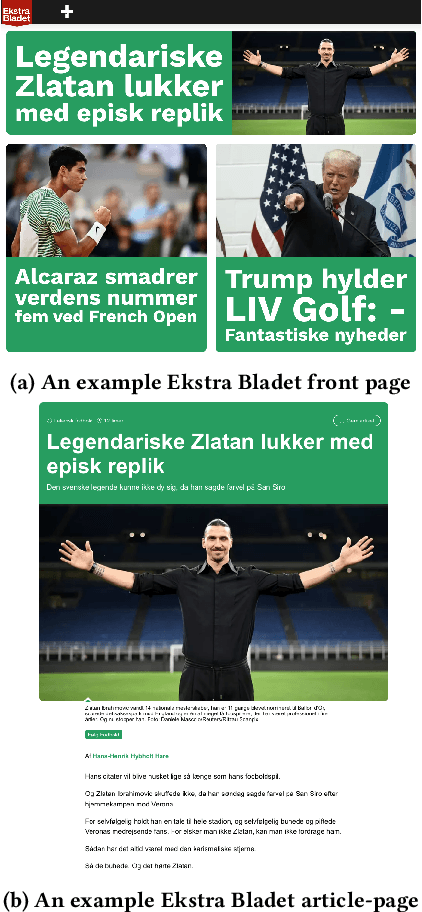
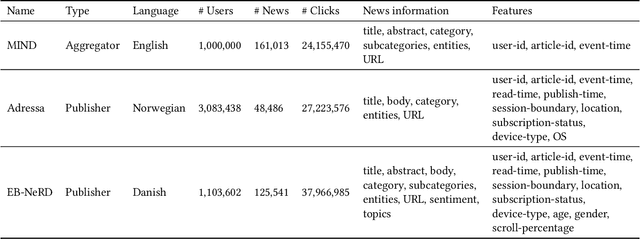

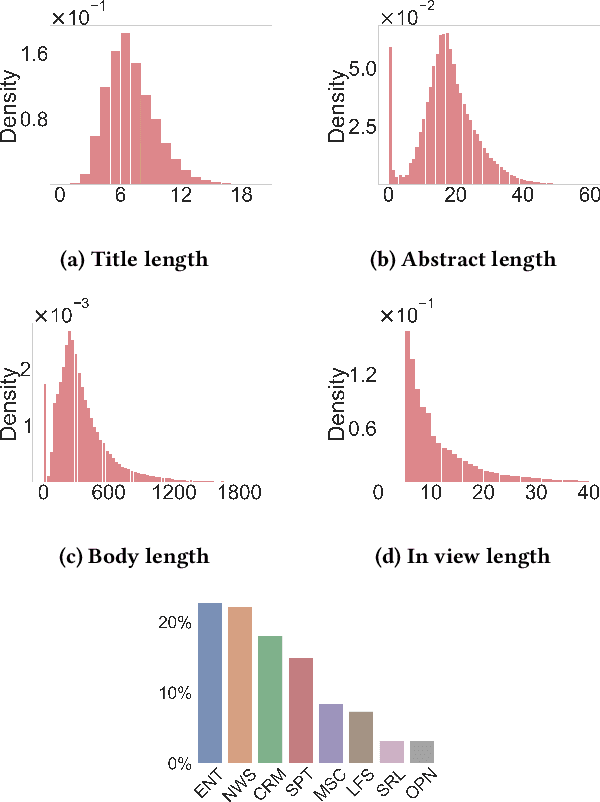
Abstract:Personalized content recommendations have been pivotal to the content experience in digital media from video streaming to social networks. However, several domain specific challenges have held back adoption of recommender systems in news publishing. To address these challenges, we introduce the Ekstra Bladet News Recommendation Dataset (EB-NeRD). The dataset encompasses data from over a million unique users and more than 37 million impression logs from Ekstra Bladet. It also includes a collection of over 125,000 Danish news articles, complete with titles, abstracts, bodies, and metadata, such as categories. EB-NeRD served as the benchmark dataset for the RecSys '24 Challenge, where it was demonstrated how the dataset can be used to address both technical and normative challenges in designing effective and responsible recommender systems for news publishing. The dataset is available at: https://recsys.eb.dk.
RecSys Challenge 2024: Balancing Accuracy and Editorial Values in News Recommendations
Sep 30, 2024

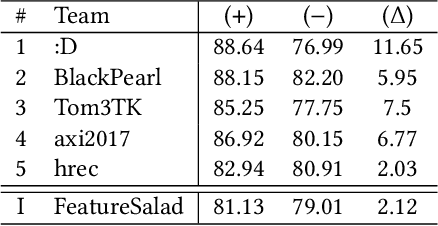
Abstract:The RecSys Challenge 2024 aims to advance news recommendation by addressing both the technical and normative challenges inherent in designing effective and responsible recommender systems for news publishing. This paper describes the challenge, including its objectives, problem setting, and the dataset provided by the Danish news publishers Ekstra Bladet and JP/Politikens Media Group ("Ekstra Bladet"). The challenge explores the unique aspects of news recommendation, such as modeling user preferences based on behavior, accounting for the influence of the news agenda on user interests, and managing the rapid decay of news items. Additionally, the challenge embraces normative complexities, investigating the effects of recommender systems on news flow and their alignment with editorial values. We summarize the challenge setup, dataset characteristics, and evaluation metrics. Finally, we announce the winners and highlight their contributions. The dataset is available at: https://recsys.eb.dk.
Variance reduction of diffusion model's gradients with Taylor approximation-based control variate
Aug 22, 2024



Abstract:Score-based models, trained with denoising score matching, are remarkably effective in generating high dimensional data. However, the high variance of their training objective hinders optimisation. We attempt to reduce it with a control variate, derived via a $k$-th order Taylor expansion on the training objective and its gradient. We prove an equivalence between the two and demonstrate empirically the effectiveness of our approach on a low dimensional problem setting; and study its effect on larger problems.
 Add to Chrome
Add to Chrome Add to Firefox
Add to Firefox Add to Edge
Add to Edge